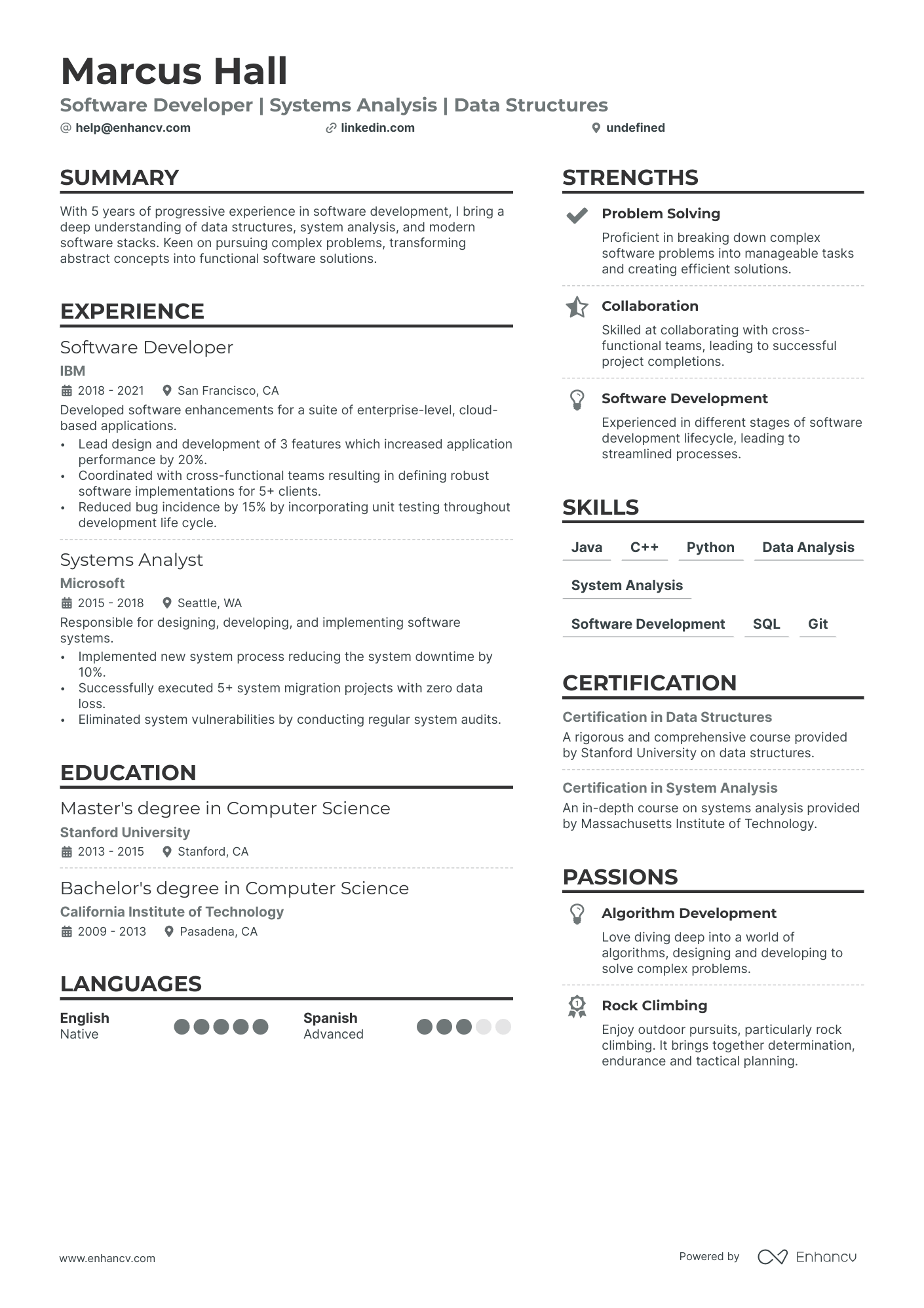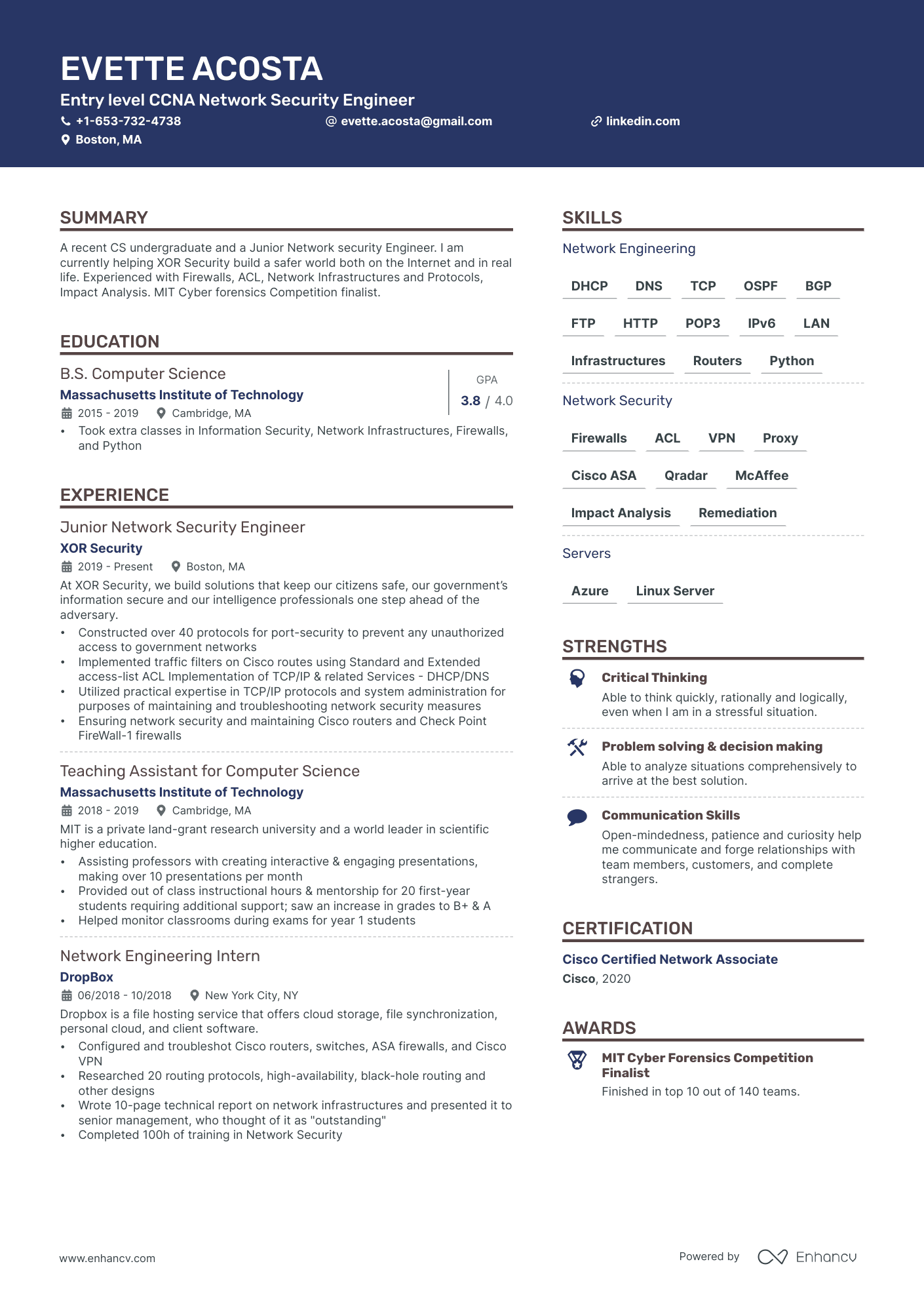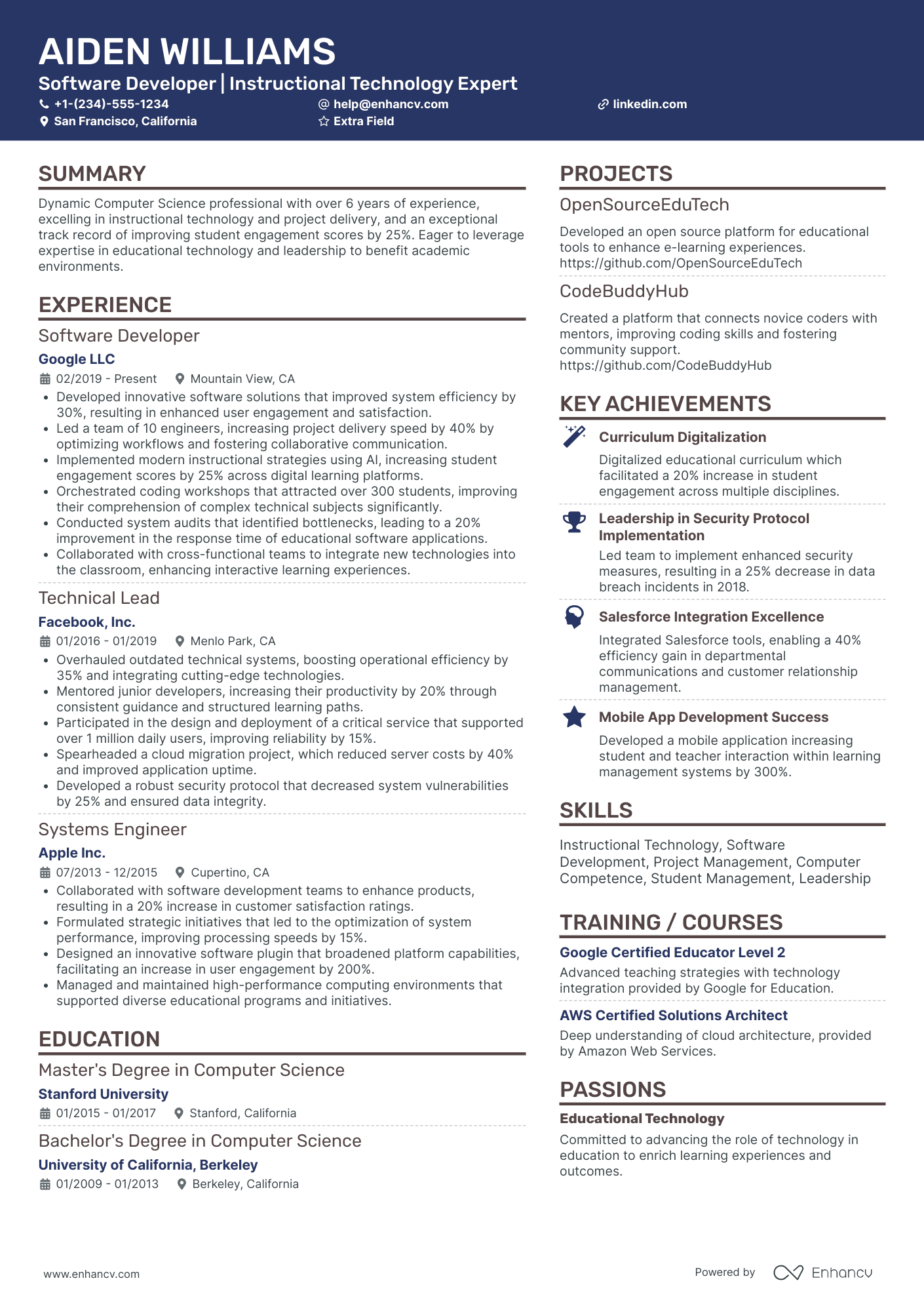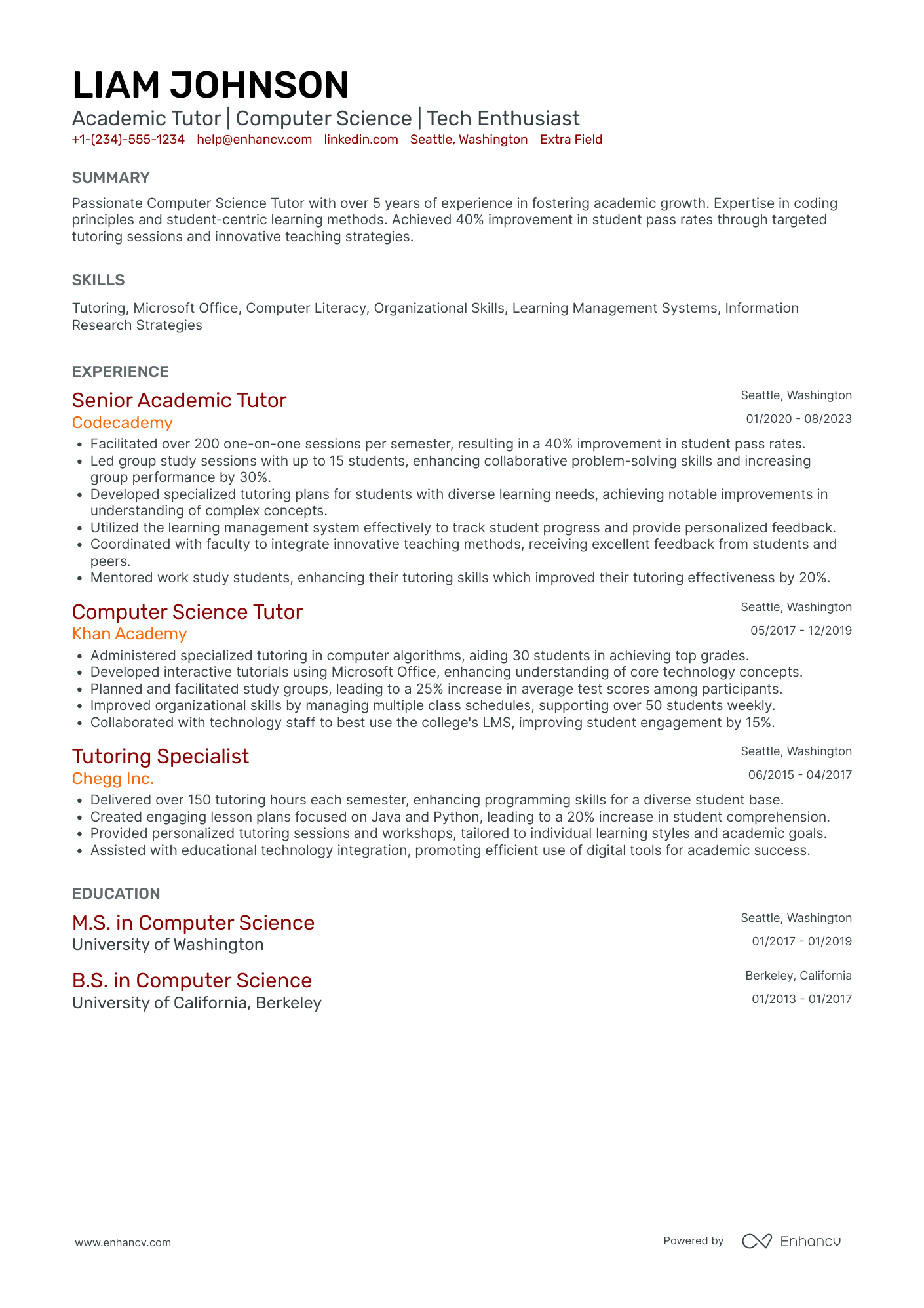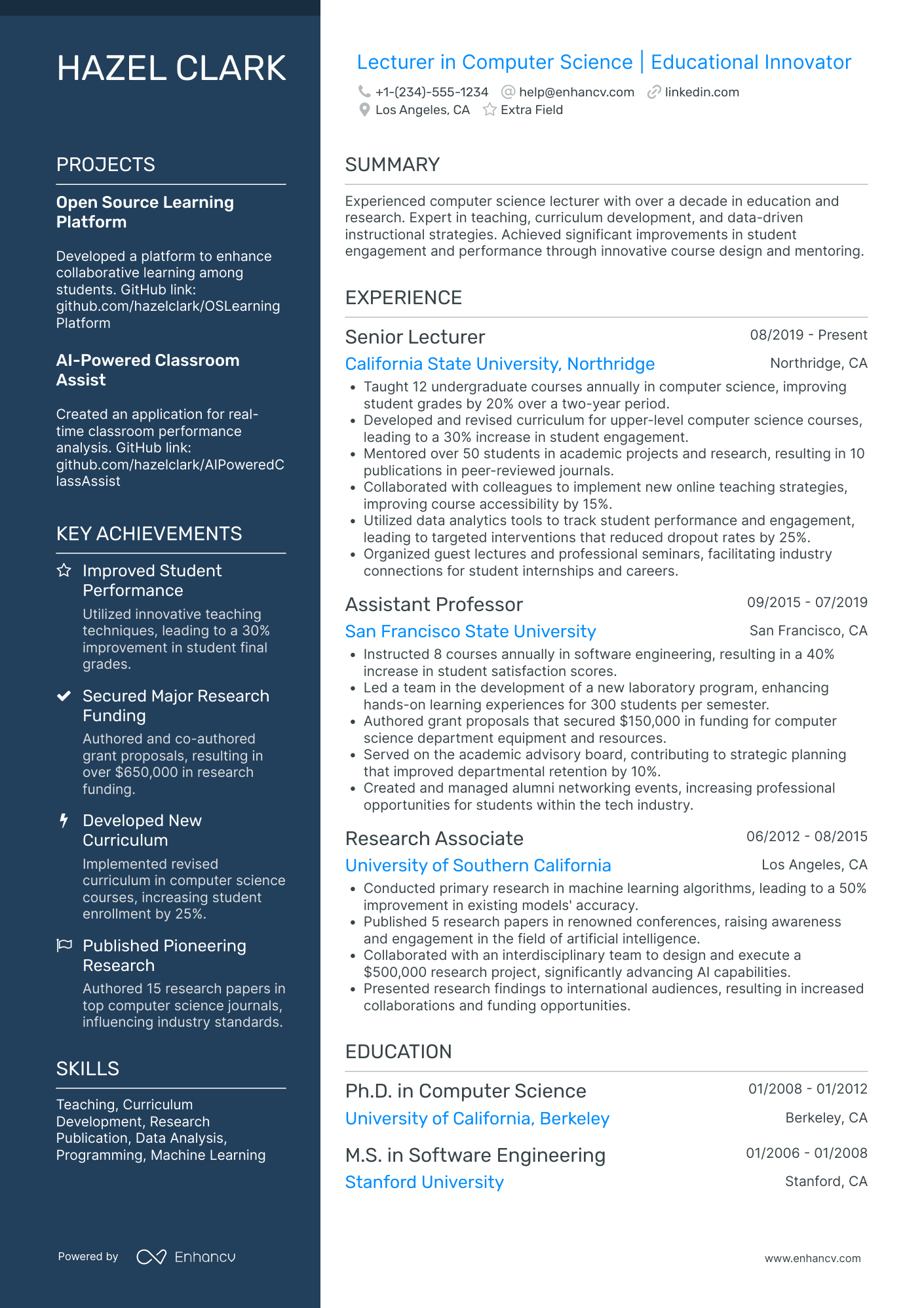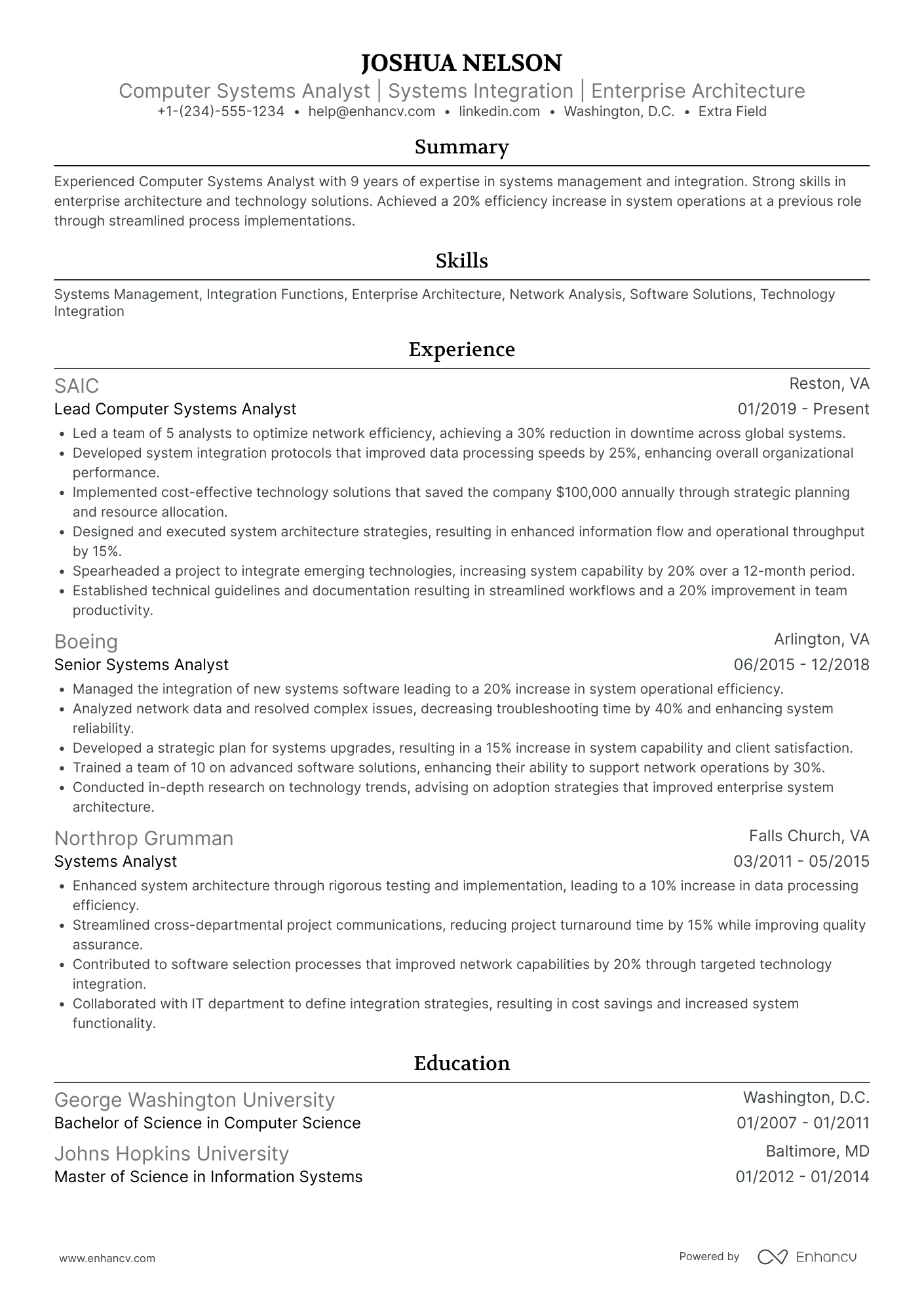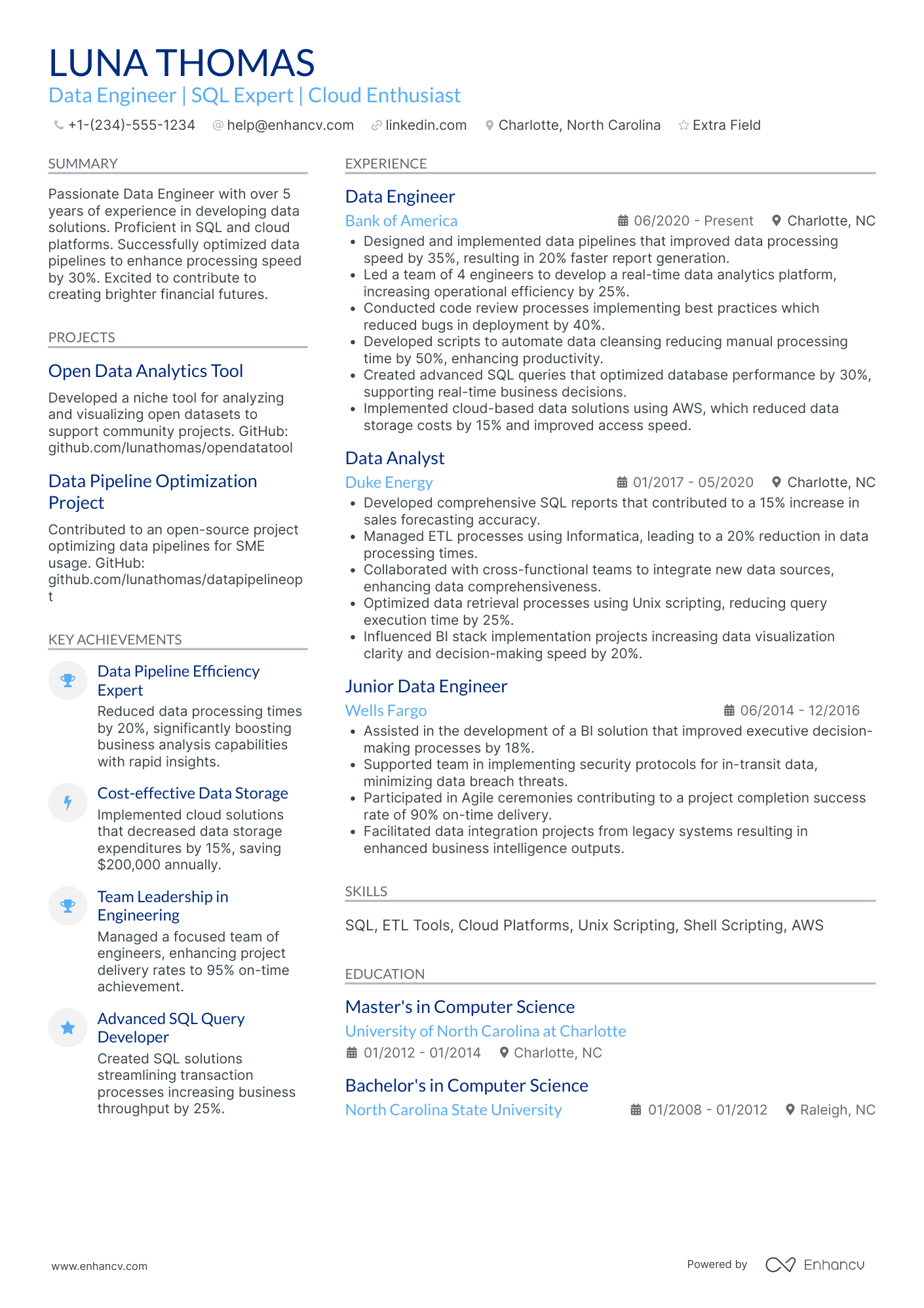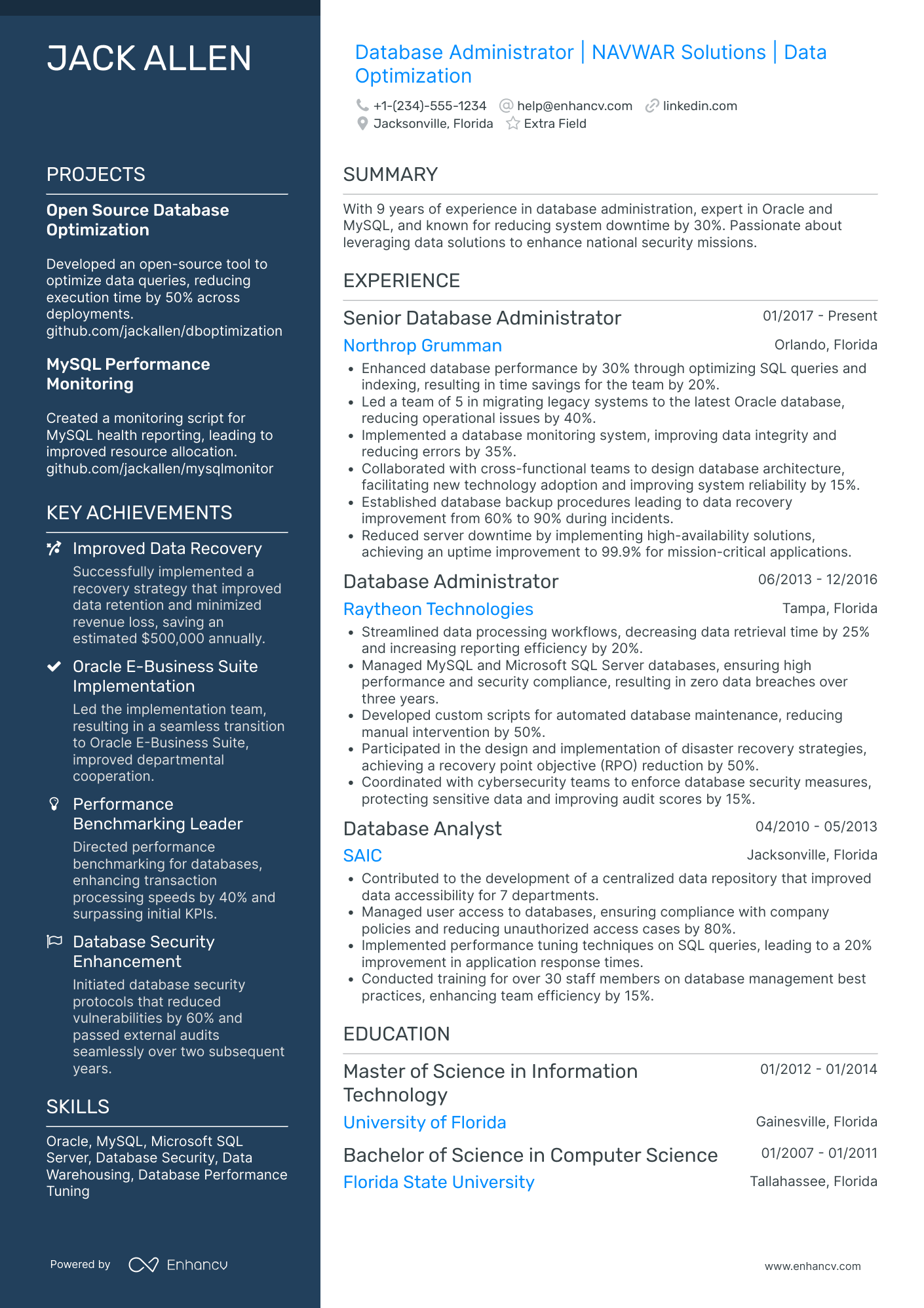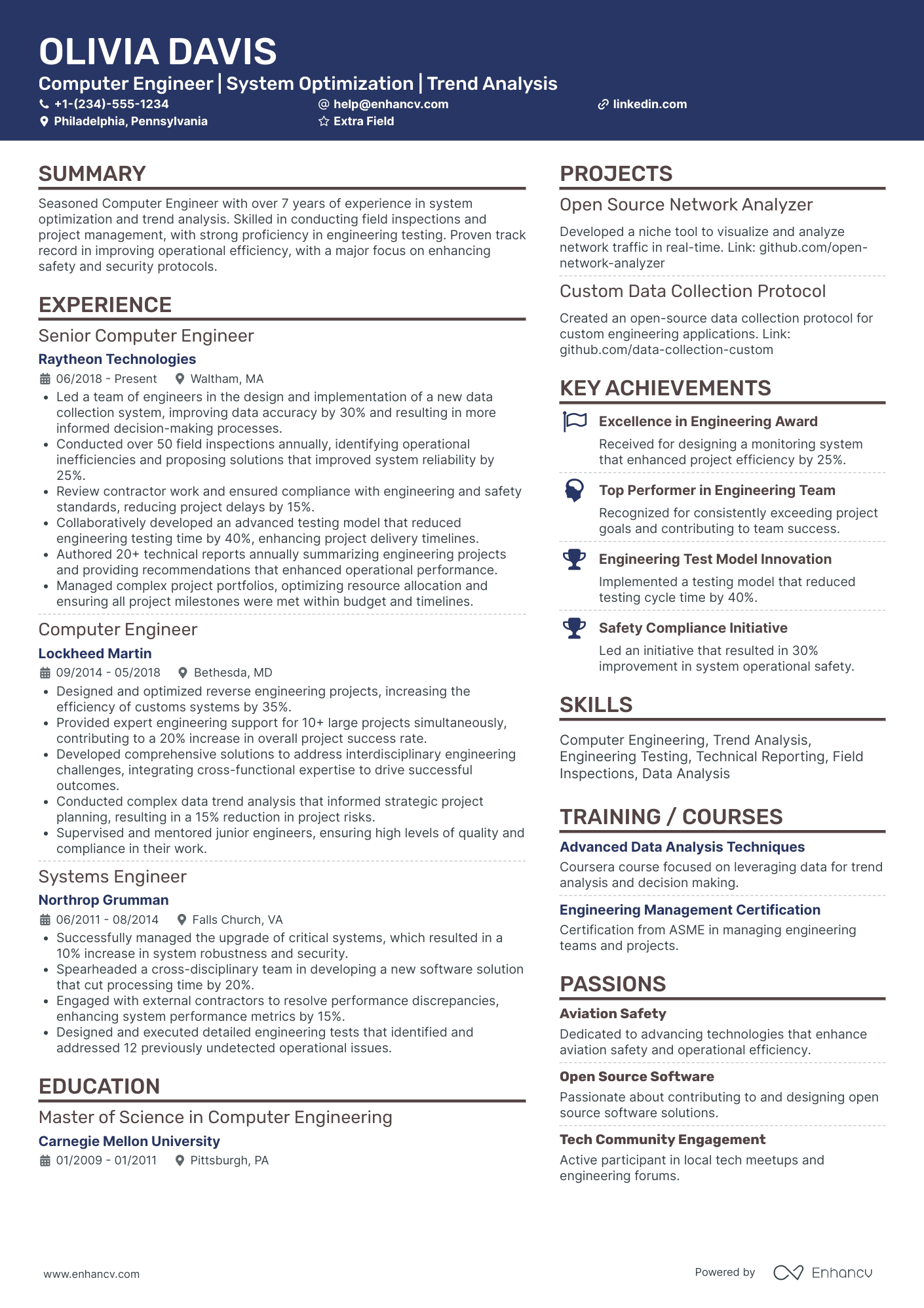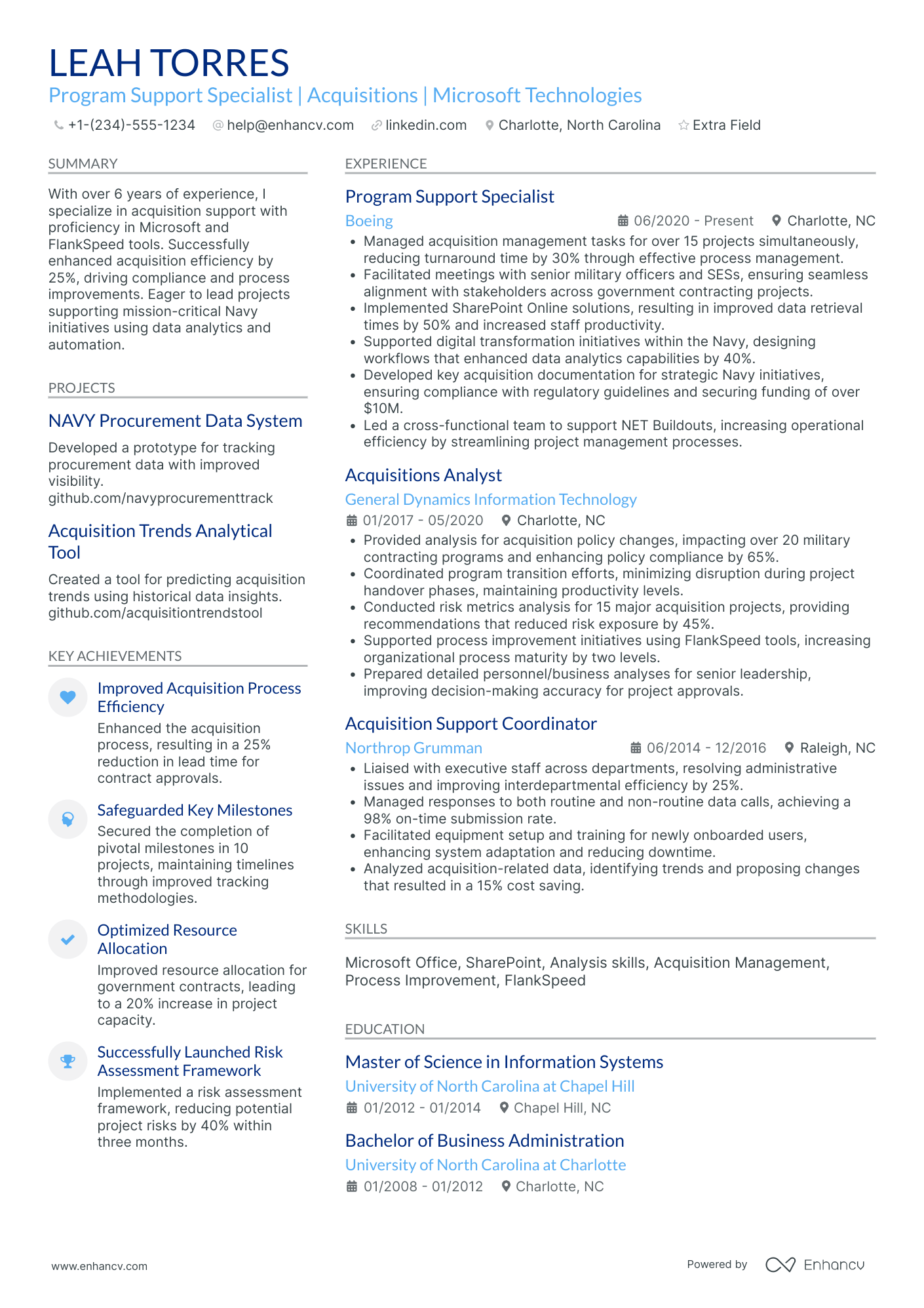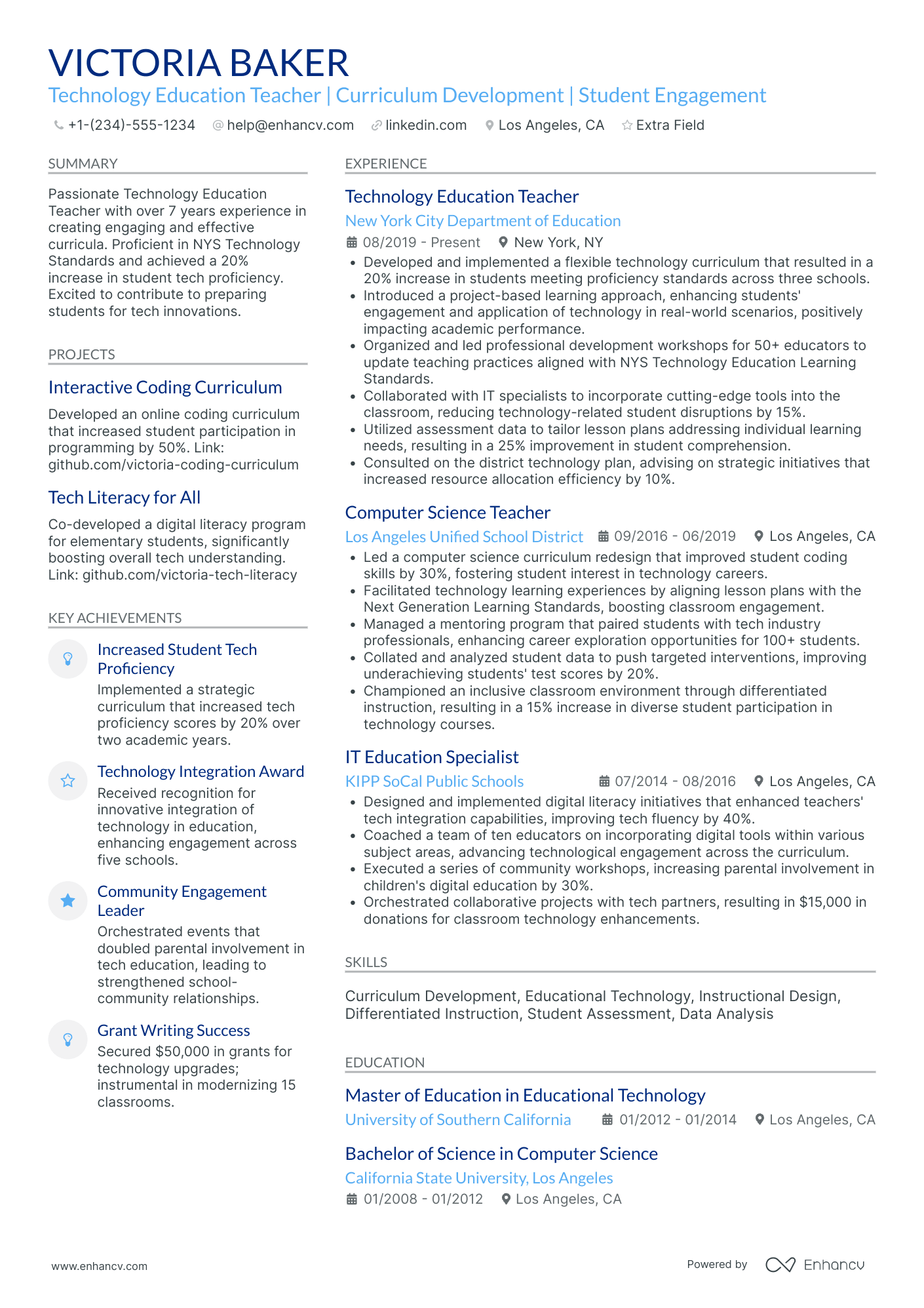The computer science job market is on a roll, expected to grow by an impressive 14.5% globally from 2021 to 2027, and, more specifically, jobs in the U.S. are set to increase by 12%. If you know how the internet, Linux, compilers, and Turing machines work, you’re in an excellent position to pursue a career in this industry. Sure, computer science can be tough and sometimes stressful, but with the right experience, you can pick and choose from the best workplaces.
Keep in mind that the first step is to catch a recruiter's attention with an outstanding computer science resume. This is something we can help you with.
In this guide we’ll explore:
- How to pick a resume template that boosts your professional look as a computer scientist.
- Which key sections you should include in your resume and how to write them.
- How to best highlight your computer science experience.
- How to list your CS achievements to show your impact.
- Which skills from the job description are critical to underscore when tailoring your resume.
Here are a few computer science-related resume guides that might interest you:
- IT Intern resume
- Entry-Level Software Engineer resume
- Entry-Level Network Engineer resume
- IT Support resume
- Data Scientist resume
- Web Developer resume
How to format a computer science resume
Selecting the best resume format in the field of computer science is essential. The goal is to spotlight your most impressive skills and achievements. In a field as dynamic and diverse as CS, your resume must pinpoint your specific strengths and how they align with the job you want. The format you choose is key to making a good first impression and ensuring your resume shows why you’re the right candidate for the job.
You have 3 main options for formatting a computer science CV:
- Reverse chronological resume: Perfect if you have a lot of relevant experience, this format lists your jobs starting with the most recent.
- Functional resume: Great for newcomers to computer science, career changers, those just starting out, or anyone with gaps in their work history. It highlights your skills more than your past jobs.
- Combination resume: This combines the best of chronological and functional resumes, allowing you to feature your most relevant skills and successes upfront, followed by a detailed job history. It’s ideal for showing off experiences that match well with computer science roles.
Make sure your resume is well organized into sections that fit these formats to catch recruiters’ attention.
Here are some useful resume tips:
- Avoid using fancy fonts that are hard for Applicant Tracking Systems to read. Stick to simple fonts like Rubik, Montserrat, Lato, or Arial, and keep the font size between 10 and 12 points.
- Use 1-inch margins on all sides of your resume to maintain a clean and professional look.
- Opt for resume colors that are easy on the eyes. Blue is an excellent choice as it's professional and commonly accepted in many business environments.
- Keep your resume concise and aim to fit everything on one page, especially if you have under 10 years of experience.
- Include your name, phone number, location, and professional email address in the header of your resume.
- Always save your resume as a PDF to ensure it looks the same on any device or platform.
Each market has its own resume standards – a Canadian resume layout may differ, for example.
Having a complete LinkedIn profile boosts your chances of getting a job interview by 71%. This underlines the importance of keeping your profile updated and fully detailed on the platform.
Improve your computer science resume with our intuitive AI resume checker. It checks 16 important areas to help your resume stand out and boost your chances of getting interviews.
Is your resume good enough?
Drop your resume here or choose a file. PDF & DOCX only. Max 2MB file size.
To strengthen your computer science resume, you’ll want to include these sections.
The top sections on a computer science resume
- Contact information: It's essential so recruiters can get in touch if they're interested in your application.
- Technical skills: Highlight specific tools, languages, and software you've mastered that are relevant to computer science roles.
- Professional experience: List your past roles, focusing on achievements related to computer science.
- Education and certifications: Show your formal education and any extra certification you've achieved in computer science fields.
- Projects: Detail your projects and explain how they’ve helped you develop your skills and achieve notable results.
The structure of your computer science resume should align with the job you’re applying for. Review the job description carefully to find relevant keywords that your resume should underscore. Here’s what you need to cover.
What recruiters want to see on your resume
- Proficiency in coding languages: Recruiters look for this as it shows the applicant's ability to write and debug software.
- Experience with data structures and algorithms: This is key to solving complex computer science problems.
- Familiarity with system design: Recruiters value this as it gives an insight into your ability to plan and manage projects.
- Understanding of AI and machine learning technologies: These are increasingly relevant and high-demand skills in tech.
- Proven problem-solving skills: Especially in a computer science context, these demonstrate your ability to tackle challenges and provide relevant solutions.
Let's get into the section regarding your previous job experience. This is the part where employers decide if your professional past conforms to what they need in a candidate for CS.
How to write your computer science resume experience
Recruiters need to see your practical knowledge of computer science in action. On your resume, emphasize your technical prowess and notable achievements in the work experience section, using powerful action verbs to describe each role and success, making your profile more engaging for potential employers.
Besides, adapting your resume for each specific job posting is key in CS for several reasons:
- Demonstrates relevant skills: Tailoring your resume enables you to highlight the skills and experiences directly pertinent to the job you're applying for.
- Illustrates dedication: It indicates genuine interest in the position and reflects your effort in researching the company.
- Ensures relevance: By customizing your resume, you can explicitly show how your previous experiences align with the job's responsibilities.
- Meets job requirements: This method enables you to address the specific qualifications outlined in the job posting, enhancing the strength of your application.
Now we’ll discuss a real CS job offer to optimize your experience entries for maximum relevance.
Example CS job offer
At Disney, we’re storytellers. We make the impossible, possible. The Walt Disney Company is a world-class entertainment and technological leader. Walt’s passion was to continuously envision new ways to move audiences around the world—a passion that remains our touchstone in an enterprise that stretches from streaming, theme parks, resorts, and a cruise line to sports, news, movies and a variety of other businesses. Uniting each endeavor is a dedication to crafting and delivering unforgettable experiences — and we’re constantly looking for innovative ways to improve these exciting experiences.
Job Title: Associate Software Engineer
As an Associate Software Engineer, you will work within the Core Systems and Platforms (CSP) Organization under the Financial Value Chain business solutions area. Finance Value Chains will be delivering Priority Business Solutions aligned with the enterprise architecture for the Finance, Tax, and Treasury Value Chains. This Associate Software Engineer position is a critical technology role, responsible for crafting and developing software primarily IBM Cognos Analytics and Planning Analytics.
Specifically this role will be responsible for developing software for:
- Financial Planning & Analysis
- Long-Range Planning
- Annual Operating Plan
- Forecasts
Responsibilities:
- Design, develop, and test highly scalable and flexible software solutions with a focus on integrations and reporting between financial systems
- Translate business requirements to design specification
- Develop, test, and deploy reports and dashboards in planning and analytics software
- Solve critical incidents by conducting root cause analysis and identifying solutions
- Partner with architects, business architects and business systems analysts, and other software and data engineers on project teams, following the Solutions Architecture model
Basic Qualifications:
- Experience in one or more related areas, i.e. SQL, Business Intelligence, Financial Reporting, Machine Learning, Data Science, and ETL
- Background in and strong understanding of broad financial systems architecture and data flow
- Business orientation (Accounting and Finance) combined with strong IT technical skills
- Wide experience with Software Development Lifecycle methodologies across waterfall and agile
- Proven track record completing projects and achieving results in an ambiguous work environment
- Must have the technical knowledge to be able to work with other teams, including third parties, Enterprise applications, and infrastructure teams
- Good communication and presentation skills, both oral and written. Ability to communicate well to both technical and business audiences
- Ability to tackle complex problems
- Innovative thinking and embraces innovation by constantly seeking new or contrary ideas and approaches to what has been done in the past
- Teamwork skills and ability to establish and manage effective working relationships in a matrixed interpersonal structure
- Results-oriented, biased toward action
Preferred Qualifications:
- Experience in test-driven software development
- Experience with integration design using data integration best practices including APIs, Messaging Bus, Pub-Sub, ETL
- Ability to work independently on certain tasks
- Keeps proficient in new technologies and successful sharing with peers and introducing new technologies
- Demonstrates stamina, resilience, and perseverance under trying circumstances
Education:
- Bachelor’s degree in Computer Science, or comparable field of study, and/or equivalent work experience
Let's compare the experience section of two candidates targeting the same job. The first candidate might find it more difficult to secure the job. Let's see why.
- •Led and managed a large software development team.
- •Collaborated across departments to develop a new time-management software tool.
- •Advocated for the adoption of a new programming framework to enhance productivity.
- •Hosted multiple workshops and presentations on the role of software development in business efficiency.
This resume entry is too vague and doesn't provide enough detail. It mentions leading a team, hosting workshops, etc. However, it doesn't explain how these were done or what the results were. This lack of detailed information fails to demonstrate the candidate’s skills or the tangible benefits they’ve brought to previous roles, making it difficult to see why they’re the best fit for the job.
On the other hand, the next applicant impresses with their strong performance.
- •Streamlined project delivery using SDLC methodologies, reducing timelines by 20%.
- •Developed new time-management software with Messaging Bus and Pub-Sub, increasing efficiency by 25%.
- •Implemented a new programming framework, cutting system errors by 30% through integration design.
- •Streamlined project delivery using SDLC methodologies, reducing timelines by 20%.
Here are the 3 main reasons why this resume captures attention:
- Quantifiable achievements: This candidate showcases impressive results with clear metrics—led a software development team of 30 members, increased productivity by 40% through effective API and ETL integrations, and successfully reduced project timelines by 20% using SDLC methodologies.
- Relevant experience: Demonstrates how the candidate effectively managed cross-departmental efforts to develop new time-management software, integrating advanced technologies like Messaging Bus and Pub-Sub to boost data flow efficiency by 25%.
- Software proficiency: Implemented a new programming framework that significantly reduced system errors by 30%, showcasing the candidate's strong grasp of integration design principles and technical acumen.
This resume ties the candidate's achievements to the job requirements really well. Keep these ideas in mind to create an experience section that’s rich with quantifiable achievements.
How to quantify impact on your resume
Adding statistics and figures can bring to life the effectiveness of your programming. It's an effective method to demonstrate the tangible impact you've made, such as enhancing system performance or optimizing software algorithms.
Check out these practical ideas to quantify your success in computer science roles.
- Include the number of programming languages you're proficient in to illustrate your versatility and adaptability in the rapidly evolving field of computer science.
- Present the number of software systems or applications you've developed to demonstrate your ability to create effective solutions.
- Mention the percentage of process improvement after the implementation of your programming project to show the actual impact of your work on business productivity.
- Specify the number of bugs or issues you've resolved in past roles to quantify your problem-solving skills.
- List the number of different databases you're fluent in to indicate your ability to manage business information effectively.
- State the rate of system uptime during your management to show how reliable your programming is on a day-to-day basis.
- Include the number of security issues you’ve prevented or repaired to prove your ability to ensure software and data security.
- Mention the number of complex algorithms you've developed or improved to emphasize your contribution to making business processes more efficient.
How do I write a computer science resume with no experience
The field of computer science is incredibly diverse and covers a lot of different jobs under just one major.
For instance, high-demand developer jobs at big companies like FAANG are tough to get into. They often require a lot of preparation for coding tests and can be pretty intense with their workload. However, many entry-level jobs are more relaxed, might not need coding tests at all, and typically offer a good salary, though not as high as the top roles.
If you don't have work experience in CS, diving into personal projects is a smart move to build your skills before you start job hunting. Simple activities like crafting small apps or tinkering with new programming tricks can lay a solid foundation. Use platforms like GitHub or Stack Overflow to sharpen your coding skills and learn more about managing software projects.
Besides technical roles, many positions don't involve coding at all, like program managers, business analysts, and sales engineers. These jobs focus more on people skills, and they can be quite rewarding financially, often with a much lighter workload.
When you're ready to apply for an entry-level job, here's how to customize your resume:
- Present your personal projects as academic or freelance work.
- Mention any tech workshops, coding contests, or hackathons you’ve participated in, especially if you walked away with any prizes.
- Include your involvement in relevant online communities, especially those centered around software development or specific coding languages.
- Spotlight transferable skills such as teamwork, analytical prowess, and handling complex projects, with real-life examples from school or previous roles that show these abilities in action.
- List references from educators or mentors, or simply indicate that they can be provided if needed.
- Begin your resume with a concise objective statement that showcases your enthusiasm for CS and any pertinent experience, keeping it to 3 or 4 sentences.
All these elements prove you're proactive and skilled—key characteristics valued in the tech industry.
How to list your hard and soft skills on your resume
Moving to the skills portion of your resume, it’s important to detail your computer science training, areas of specialization, and practical experience in the field. This technical knowledge underlines your readiness for a role in the tech industry.
Let's focus on your hard skills.
Hard skills
Underlining your hard skills is key because they demonstrate your expertise in specific programming languages and technical practices, which are crucial for any tech role. Start by setting up a clear "Hard skills" section on your resume, ideally right after your work experience details. This is where you list and prioritize your technical abilities, such as programming languages, development tools, and frameworks you're skilled in.
Make sure to tailor these skills to fit the job you're aiming for. If you’ve got a wide range of technical skills, try breaking them down into categories like "Programming languages," "Development tools," and "Frameworks" for easy reading.
Dropping these skills into your resume will definitely give it a solid boost!
Best hard skills for your computer science resume
- Java programming
- Python programming
- C++ programming
- Machine learning
- Artificial Intelligence (AI)
- Data structures
- Algorithm development
- Database management (SQL, Oracle)
- Web development (HTML, CSS, JavaScript)
- Software development
- Debugging
- Cloud computing (AWS, Google Cloud)
- Cybersecurity
- Data Science
- Network architecture
- System design
- Linux
- Front-end frameworks (React, Angular)
- Back-end technologies (.NET, Node.js)
- DevOps and automation tools (Jenkins, Docker)
Alongside your hard skills, make sure your computer science resume includes a list of soft skills, emphasizing your broader personal strengths.
Soft skills
Soft skills are important for your CS resume because they show you can work well with others and handle changes smoothly. Instead of putting these skills in a separate section, spread them throughout your resume.
In your summary or objective, give real examples of how you’ve used them. Also, point out relevant soft skills in your work experience and education sections, showing how you’ve used teamwork and leadership in tech-related situations.
Make sure your skills fit what the job ad is looking for and mix them with your tech expertise to build a targeted resume that really shows off a balanced profile.
Here are some soft skills that are often appreciated in computer science:
Best soft skills for your computer science resume
- Problem-solving
- Creativity
- Communication
- Attention to detail
- Time management
- Analytical thinking
- Teamwork
- Adaptability
- Self-motivation
- Patience
- Leadership
- Negotiation
- Empathy
- Responsibility
- Decisiveness
- Initiative
- Confidence
- Learning agility
- Resilience
- Integrity
How to list your certifications and education on your resume
Computer science empowers students to create the world of tomorrow.
Satya Nadella, CEO of Microsoft
In the field of computer science, aspects such as education and certifications do more than fill out your resume. They underscore your capability and validate your theoretical knowledge as well as your expertise in practical tech skills. This will position you as a standout candidate in the crowded tech landscape. Think of them as your credentials that signal to employers that you’re well-prepared.
Without these qualifications, your resume may not stand a chance.
PRO TIP
When applying for entry-level jobs, make sure to underline your educational background, especially relevant coursework, to show you're prepared for the tech field.
Let's explore how to detail the education part of your resume and what elements are essential.
- Degree title: Specify the degree you’ve earned related to computer science.
- Institution name: List the educational institution where you studied.
- Graduation year: Indicate when you graduated or when you anticipate graduating.
- Major: Highlight your area of specialization, such as computer science, software engineering, or information technology, which are directly relevant to CS positions.
- Additional training: Mention any supplementary courses or workshops you’ve attended that enhance your CS skills, such as data structures, algorithms, or cybersecurity.
- GPA: If your Grade Point Average is above 3.5, consider including it to highlight your academic excellence.
Here’s an example:
- •Specialization: Software Engineering
- •Relevant Coursework: Data Structures, Algorithms, Computer Systems, Network Security
- •Capstone Project: Developed a scalable e-commerce platform using microservices architecture
- •Pursuing advanced placement courses in mathematics and computer science
Students who study computer science unlock a world of opportunities for themselves.
Dr. John Deasy, Former Superintendent, Los Angeles Unified School District
On top of that, highlighting advanced computer science certifications on your resume demonstrates your commitment to skill enhancement and problem-solving within the field:
- List each certification you’ve obtained.
- Specify the organization that issued each certification.
- Note the expiration date if it’s relevant.
Review these leading computer science certifications:
Best certifications for your computer science resume
Once you've detailed your educational background in computer science, it’s time to focus on the beginning of your resume. We can do that by creating a summary that neatly showcases your skills and significant accomplishments.
How to write your computer science resume summary or objective
A good way to show your work ethic and attitude towards your career is to write a quality resume summary or objective statement. Both elements are key to quickly grabbing a recruiter’s attention and showing that your skills and experiences are a good match for the job.
Here’s a breakdown of the two:
- Summary: This should be a concise overview of your major professional achievements and key skills, ideally in 3 to 5 sentences. Opt for this format if you have extensive experience in computer science.
- Objective statement: Keep this brief, around 3 sentences, focusing on your career objectives and why you're interested in the specific role. This format is best suited if you’re just entering the field of computer science, transitioning careers, or returning to the workforce.
Curious to see what they look like in action? Let’s take a look at a sample resume summary next.
Let's go ahead and review an example of an objective statement as well.
Here are some tips for crafting a compelling resume summary or objective for a computer science position:
- Personalize it: Tailor your summary or objective to reflect the specific computer science role and the company culture you're targeting. Show how your skills meet their requirements.
- Use relevant numbers: Boost your credibility by quantifying your achievements. This is a good example, "Successfully increased efficiency by 30% through innovative coding solutions."
- Focus on key skills: Highlight essential computer science skills such as proficiency in programming languages like Python and Java, and strong problem-solving abilities to collaborate effectively across teams.
Perfecting a brief and accurate summary or objective can significantly enhance your resume.
Optimize your resume summary and objective for ATS
Drop your resume here or choose a file.
PDF & DOCX only. Max 2MB file size.
Additional sections for a computer science resume
To enhance your computer science resume, consider adding a few extra sections. These can provide recruiters with a more comprehensive view of your capabilities:
- Passions: Sharing your interests outside of work, such as open-source contributions, blogging, or hiking, can illustrate that you’re a well-rounded individual with a genuine passion for technology.
- Achievements: Highlight significant accomplishments such as awards, scholarships, or successful software projects to showcase your dedication and effectiveness in the field.
- Volunteer work: If you have volunteer experience, especially in roles related to technology or teaching, include it. It demonstrates your commitment to the community and willingness to extend your skills beyond professional engagements.
- Language skills: Mention if you’re proficient in foreign languages. This can be a valuable asset in a diverse tech environment.
How to put a projects section on a computer science resume
The project section presents significant endeavors in the field of computer science, detailing their objectives, the methodologies employed, your roles, and the outcomes realized. It offers a clear depiction of each project's influence and success within the field.
Check this example:
- •Spearheaded a performance enhancement initiative for a mobile app, utilizing JMeter to optimize load times and increase efficiency by 30%.
Adding a projects section to your computer science resume is a smart move because it shows your technical knowledge and problem-solving skills through real-life applications. Plus, it also gives you some cool examples to talk about in interviews. It's a great way to demonstrate how you handle complex challenges and work with others, really making your resume unique. Moreover, it gives you a chance to dive into the details of what you've accomplished, which can be a real game-changer during interviews. So, don't underestimate the importance of this section.
Key takeaways
With the foundation set, let’s recap what’s essential for your computer science resume.
- Choose a resume template that presents your professional image effectively.
- Always update your LinkedIn profile as it significantly enhances your job prospects.
- Include key sections such as technical skills, professional experience, and projects.
- Highlight your computer science experience with specific examples.
- Detail your achievements in a way that shows your impact on past projects.
- Emphasize critical skills mentioned in the job description to tailor your resume.
- List important CS certifications that align with your career goals and the job requirements.
Computer Science resume examples
By Experience
Computer Science Internship
Entry-Level Computer Science
Junior Computer Science
Mid-Level Computer Science Professional
Senior Computer Science Professional
Entry-Level Computer Science Professional
Computer Science Intern
By Role
